Persian cats can exhibit various behavior problems. The most common are Aggression, Excessive Grooming, Excessive Meowing, Litter Box Issues, Destructive Scratching, Separation Anxiety, Unnecessary Jumping, Inappropriate Elimination, Fearful Behavior, Obsessive Compulsive Disorders (OCD), and Eating Disorders.
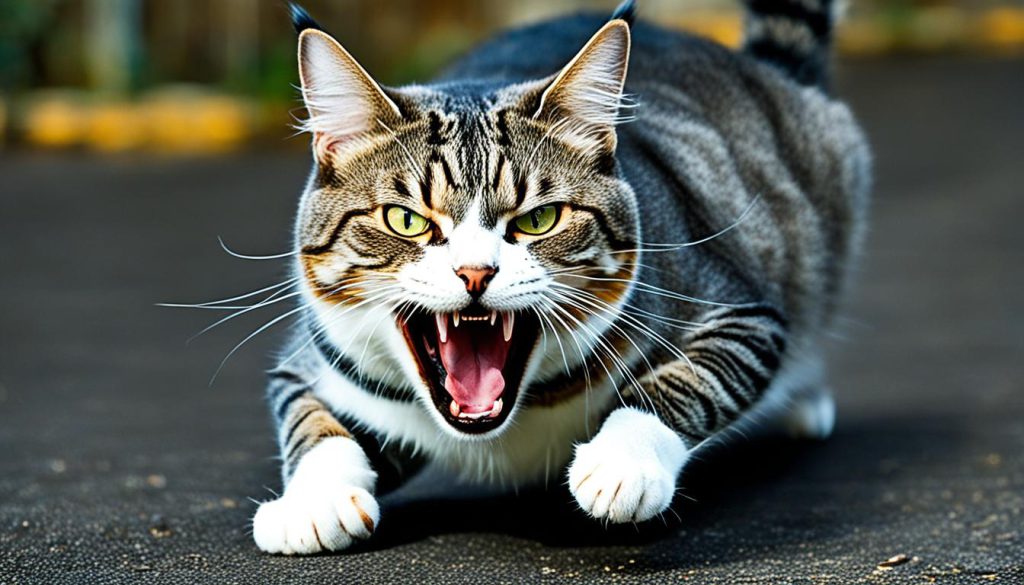
I’ll share why Persian cats show these behavior problems in this blog. And also explain the strategies to overcome them. Let’s dive in!
Research on Behavior Problems in Cats:
Research on Feline Behavior Problems and Risk Factors for Behavior Problems in Cats has been conducted including Persian cats. Here are the results:
| Behavioral Problem | Percentage of Cats Affected | Results |
| Fearfulness | 45.5% | Most common complaint; includes hiding and aggression as signs. |
| Attention Seeking | 37.1% | Second most common; may lead to vocalization and other disruptive behaviors. |
| Aggression Towards Other Cats/People | Not specified | Less common in Persian cats; and more prevalent in other breeds. |
| Scratching | Not specified | Includes destructive scratching of furniture and other items. |
| Inappropriate Elimination | Not specified | Persian cats reported having more house-soiling problems. |
Study Overview:
- Location: Tehran, Iran
- Sample Size: 167 cats
- Method: A questionnaire consisting of 40 behavioral questions
- Key Findings:
- 94.6% of cat owners reported at least one undesirable behavior.
- Persian cats showed fewer tendencies for aggressive behaviors towards people.
- More owners reported house soiling in Persian cats.
- Only 11.4% of owners sought professional help for their cats’ behavioral issues.
Factors Associated with Behavioral Problems in Cats:

1. Age:
Older cats tend to show increasing tolerance of familiar situations.
Age is linked to attention-seeking behavior. Older cats are more likely to seek attention.
2. Breed:
Those include Persian, Siamese, and Burmese. They are more prone to behavior problems than companion cat breeds.
3. Outdoor Access:
Outdoor access could be a risk factor for elimination problems in cats.
4. Owner Reaction Towards Behavior:
How owners react to their cats’ behavior can impact their scratching.
5. Cat’s Interaction with Other Cats/People:
Interaction with other people can positively impact reducing a cat’s scratching behavior.
11 Persian Cat Behavior Problems :
Aggression:
Aggression in Persian cats, while not as common as in other breeds, can perplex owners. It’s often a sign of deeper problems—these range from stress and fear to medical issues.

Causes of Aggression:
- Medical issues cause pain. They come from conditions like dental disease or arthritis. Pain makes a cat more irritable and prone to aggression.
- A cat may become aggressive if it feels threatened or cornered.
- Cats are naturally territorial. Persians may show aggression to defend their space.
- Play Aggression- sometimes, what appears to be aggression is rough play, especially in younger cats.
Signs of Aggression:
- Hissing, Growling, or Spitting are clear vocal signals that a cat is not in a friendly mood.
- Swatting or Biting: Physical actions like these are direct expressions of aggression.
- Stalking or Pouncing: These behaviors can indicate play aggression or a more serious intent to confront.

Dealing with Aggressive Behavior:
- Identify Triggers: Observe when and why your cat becomes aggressive to address the specific cause.
- Create a Safe Space: Ensure your cat has a quiet, comfortable place to retreat when stressed.
- Consult a Vet: Rule out any medical issues that can cause pain or discomfort.
- Behavior Modification: Use positive reinforcement to encourage good behavior and discourage aggression.
Excessive Grooming Behavior
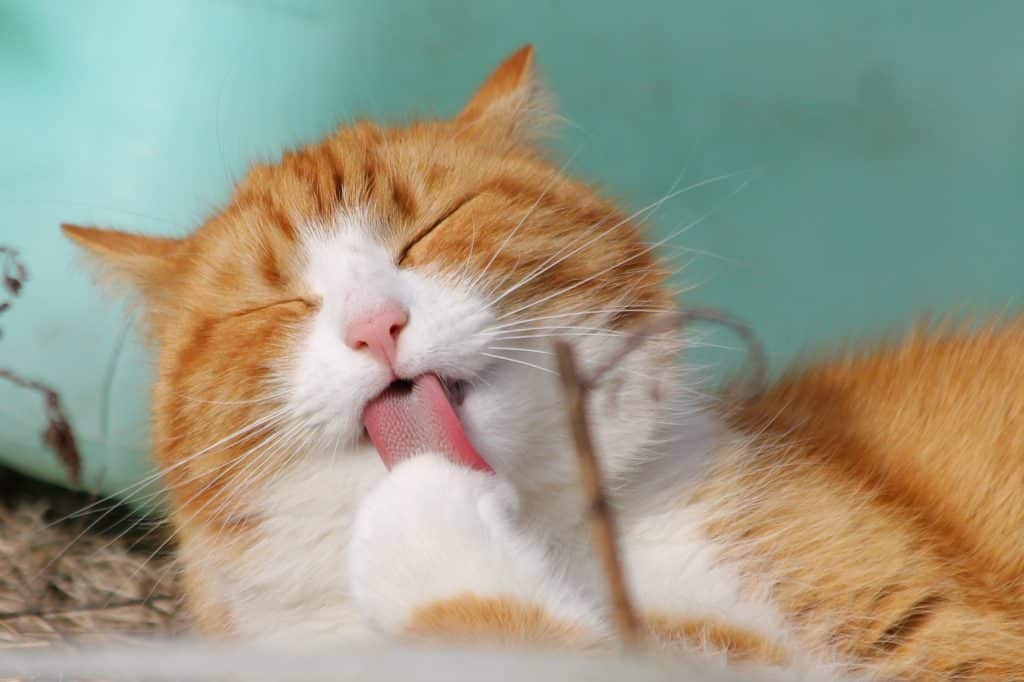
Persian cats are known for their luxurious coats, which require regular maintenance.
Sometimes these cats may engage in excessive grooming, which leads to skin irritation or hair loss.
To identify why your Persian cat over-grooms is key. It helps prevent health issues.
Understanding Over-Grooming:
Over-grooming, or psychogenic alopecia, occurs when a cat licks itself excessively, often as a response to stress or anxiety.
It can also indicate underlying health issues, such as allergies or parasites.
Health Issues Related to Over-Grooming:
Excessive grooming can lead to skin infections, hot spots, and even gastrointestinal problems if the cat ingests too much hair.
It’s important to monitor your cat’s grooming habits and seek veterinary advice if you notice any bald patches or skin lesions.
Strategies to Reduce Over-Grooming:
- Add toys and activities to keep your Persian cat mentally stimulated.
- Ensure your cat is free from health issues that could be causing discomfort.
- Identify and minimize stressors in your cat’s environment. This could include changes in the household or conflicts with other pets.
Excessive Meowing in Persian Cats

Excessive meowing in Persian cats can be a behavior problem owners may encounter.
This behavior is because of various underlying issues.
1. Attention-Seeking Behavior: Persian cats may excessively meow to seek attention from their owners.
This behavior is often a way for the cat to communicate its needs or desires, such as hunger, playtime, or affection.
2. Anxiety or Fear: Excessive meowing can also indicate anxiety or fear in Persian cats.
They may vocalize more when they feel threatened, scared, or uncomfortable.
This is due to changes in their environment or the presence of other animals.
3. Health Concerns: Changes in a Persian cat’s meowing are the issue. They are concerned if they become excessive or alter in tone or volume.
They could indicate a health problem. Cats may meow more when they are in pain or discomfort. This can prompt owners to seek vet advice for diagnosis and treatment.
4. Behavioral Issues: Excessive meowing can lead to behavioral problems if not addressed appropriately.
It may result from a lack of attention, boredom, or other unmet needs in the cat’s environment. Playing, enrichment activities, and proper responses to meowing can help manage this behavior.
Litter Box Issues
Persian cats have long fur and a dignified demeanor. They can sometimes develop litter box issues. This can be quite distressing for both the cat and the owner.
Reasons for Litter Box Avoidance
Several factors can contribute to a Persian cat’s reluctance to use the litter box:
- Discomfort: Long-haired breeds may find certain types of litter uncomfortable on their paws or may get litter stuck in their fur.
- Cleanliness: Cats are fastidious creatures, and a dirty litter box can deter them from using it.
- Location: If the litter box is in a noisy or high-traffic area, your cat may feel too exposed to use it.
- Medical Issues: Health problems like urinary tract infections can also lead to litter box avoidance.
Solutions for Litter Box Problems
- Multiple Boxes: Having more than one litter box, especially in a multi-cat household, can help.
- Appropriate Litter: Experiment with different types of litter to find one that your Persian cat prefers.
- Regular Cleaning: Keep the litter box clean and scoop it at least once a day.
- Privacy: Place the litter box in a quiet, accessible location where your cat can feel secure.
Maintaining Good Litter Box Habits
- Consistency: Don’t move the litter box around; keep it in the same place so your cat always knows where it is.
- Positive Reinforcement: Reward your cat for using the litter box properly to encourage good habits.
- Veterinary Check-Up: If problems persist, consult your vet to rule out any underlying medical conditions.
Destructive Scratching

Persian cats have plush coats and a calm demeanor. But, they may scratch and damage furniture and other items.
Why Persian Cats Scratch?
Scratching is a natural behavior for cats, serving several purposes:
- Territory Marking: Cats have scent glands in their paws, and scratching leaves both a visual mark and a scent cue to other cats.
- Nail Maintenance: Scratching helps cats shed the outer layers of their nail sheaths, keeping their claws sharp and healthy.
- Stretching: It’s a way for cats to stretch their bodies and flex their feet and claws.
- Stress Relief: Scratching can be a way for cats to relieve stress or express excitement.
Providing Appropriate Scratching Outlets:
To prevent destructive scratching, it’s important to provide appropriate outlets:
- Invest in sturdy scratching posts or pads. They should be made from materials that cats like, such as sisal or cardboard.
- Place scratching posts near your cat’s favorite resting areas and where they spend the most time.
- Use catnip or toys to attract your cat to the scratching post.
Preventing Unwanted Scratching:
- Furniture Protection: Use furniture protectors or deterrent sprays to make furniture less appealing.
- Regular Nail Trimming: Keeping your cat’s nails trimmed can reduce the damage they can do when scratching.
- Positive Reinforcement: Reward your cat for using the scratching post instead of the furniture.
Separation Anxiety
Persian cats are affectionate. This can lead to a strong dependence on their human companions.
This can lead to separation anxiety when they’re left alone.
Signs of separation anxiety in Persian cats can include:
- Excessive Vocalization: Meowing or crying more than usual when you’re not around.
- Destructive Behavior: Engaging in activities like paper shredding or scratching at doors.
- Litter Box Amnesia: Forgetting their litter box training and eliminating inappropriate places.
Preventing and Treating Separation Anxiety:
- Environmental Enrichment: Provide toys and puzzle feeders to keep your cat occupied while you’re away.
- Gradual Desensitization: Practice short departures to get your cat used to being alone.
- Consistent Routine: Cats thrive on routine, so try to keep your comings and goings as regular as possible.
Enrichment Ideas for Lonely Cats:
- Interactive Toys: Toys that mimic prey movements can engage your cat’s hunting instincts.
- Companion Play: Consider getting another pet for company, if appropriate for your situation.
- Cuddly Comfort: Leave a piece of clothing with your scent on it to provide comfort to your cat.
Unnecessary Jumping

Persian cats may sometimes develop a habit of jumping onto high surfaces like countertops or furniture.
While this is a natural behavior for many cats, it can become problematic if it leads to accidents or damage.
Train your Cats to Stay Off Counters by:
- Provide Alternatives: Offer cat trees or designated shelves where your cat is allowed to climb.
- Discourage Jumping: Use deterrents like double-sided tape or aluminum foil on surfaces where you don’t want your cat to jump.
- Positive Reinforcement: Reward your cat when they use appropriate areas for climbing and jumping.
Alternatives to Counter Surfing:
- Interactive Play: Engage your cat in playtime with toys that satisfy their urge to jump and climb.
- Scheduled Feeding: Ensure your cat is not jumping on counters in search of food by sticking to a regular feeding schedule.
Keeping Your Cat Safe and Your Counters Clean:
- Remove Temptations: Keep food and other enticing items out of reach to discourage jumping.
- Safety Precautions: Make sure your cat can access no dangerous items or substances on the counters.
Inappropriate Elimination

Inappropriate elimination is a big issue for Persian cats. They may choose to relieve themselves outside the litter box.
This behavior can be triggered by various factors, including:
- Stress or Anxiety: Any change in the environment or routine can upset a cat.
- Medical Issues: Health problems like urinary tract infections or kidney issues can lead to this behavior.
- Litter Box Discontent: Dislike of the litter type, box location, or cleanliness can cause avoidance.
Medical vs. Behavioral Causes
Determining whether the cause is medical or behavioral is crucial:
- Veterinary Check-Up: A thorough examination can rule out or confirm any health issues.
- Observe your cat’s behavior and environment. They can provide clues to non-medical causes.
Solutions for Inappropriate Elimination
- Make the litter box more appealing. Make the bad areas less inviting.
- Modify your cat’s behavior. Retrain them to use the litter box gradually by using positive reinforcement.
- Stress Reduction: Identify and minimize stressors in your cat’s life.
Fearful Behavior
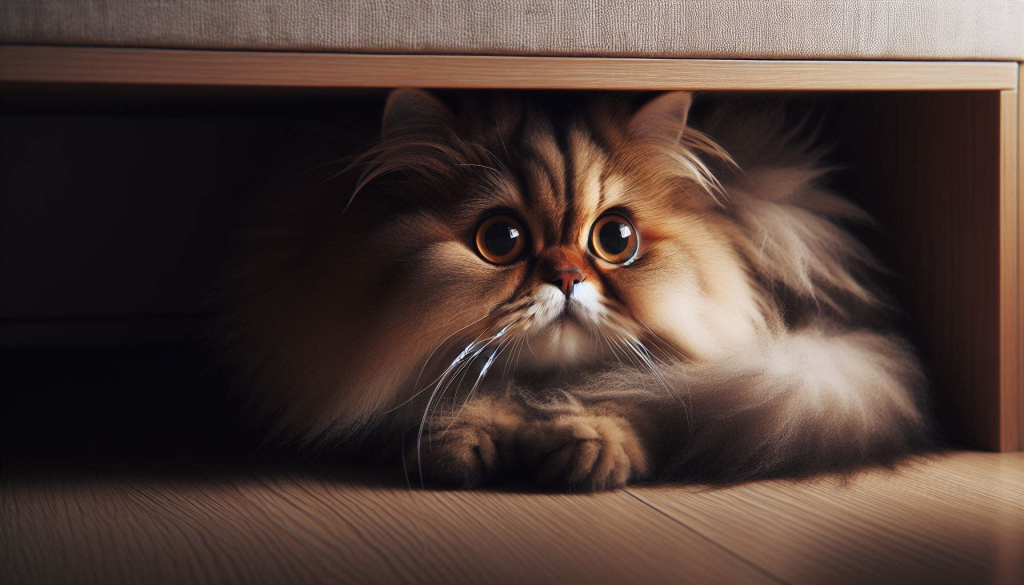
Persian cats are often perceived as calm and composed but they can experience fear, which may lead to a range of behavior problems.
Fear in Persian cats can manifest in various ways:
- Hiding: A common response to fear is seeking refuge under furniture or in secluded spots.
- Aggression: Fear can cause a typically gentle cat to become defensive and lash out.
- Freezing: Some cats may become immobile when facing a frightening situation.
Common Fears in Persian Cats
- Loud Noises: Thunderstorms, fireworks, and loud appliances can terrify sensitive cats.
- New People or Animals: Strangers or new pets can be intimidating, causing fear and stress.
- Changes in Environment: Moving to a new home or rearranging furniture can unsettle a Persian cat.
Helping Your Cat Overcome Fear
- Safe Spaces: Provide a safe, quiet place where your cat can retreat when scared.
- Slow Introductions: Gradually introduce new people or pets to avoid overwhelming your cat.
- Familiarity and Routine: Maintain a consistent routine to give your cat a sense of security.
Obsessive Compulsive Disorders (OCD)
Cats often have obsessive-compulsive disorders. These show repetitive and exaggerated behaviors. This can distress both the cat and the owner.
OCD behaviors in Persian cats might include:
- Excessive Licking: Beyond normal grooming, leading to bald patches.
- Pacing or Circling: Repeatedly walking in the same pattern or area.
- Chewing: Obsessively chewing on objects, fabric, or even themselves.
Common OCD Behaviors in Persians
Specific to Persian cats, OCD behaviors may be less about aggression and more focused on grooming or pica (the desire to eat non-food items).
Treatment and Management of OCD
- Environmental Enrichment: Providing a stimulating environment can help reduce stress-related OCD behaviors.
- Behavioral Therapy can help. A feline behaviorist can offer strategies to redirect and manage these compulsions.
- In some cases, vets may prescribe medications. They help manage OCD symptoms.
Eating Disorders

Persian cats can have eating disorders. These can range from overeating to anorexia. Identifying these conditions is vital for keeping the cats healthy.
Types of Eating Disorders in Cats
- Overeating: Can lead to obesity and related health issues.
- Under-eating or Anorexia: This may indicate underlying health problems or stress.
- Pica: The desire to eat non-food items, which can be dangerous.
Eating disorders can have serious impacts:
- Obesity: Increases the risk of diabetes, liver disease, and joint problems.
- Anorexia: This can lead to liver issues like hepatic lipidosis if not addressed quickly.
- Pica: Ingesting non-food items can cause intestinal blockages or poisoning.
Managing and Treating Eating Disorders
- Dietary Management: Work with your vet to create a balanced diet plan.
- Environmental Enrichment: Reduce stress and boredom, which can contribute to eating disorders.
- Regular Vet Check-Ups: Early detection and treatment of any medical issues.
The Role of Pheromone Diffusers
Pheromone diffusers can help manage stress in Persian cats. They reduce stress-related behaviors.
How Pheromones Can Help?
Pheromones are chemical signals that can have a calming effect on cats. Diffusers that emit synthetic versions of these pheromones can help:
- Reduce Stress: They can create a reassuring environment for anxious cats.
- Minimize Aggression: Pheromones can help soothe tensions between cats in multi-cat households.
- Promote Relaxation: They can aid in making your cat feel more secure and relaxed at home.
When choosing a pheromone diffuser:
- Research: Look for products with positive reviews from cat owners and veterinarians.
- Placement: Install the diffuser in the area where your cat spends most of their time.
- Monitoring: Observe your cat’s behavior to ensure the diffuser has the desired effect.
Interactive Toys and Feeders

Toys and Feeders are great for engaging Persian cats. They also prevent boredom behaviors.
Benefits of Mental Stimulation
Keeping your cat’s mind active with interactive toys is crucial for their overall well-being:
- Prevent Boredom: They provide essential mental stimulation.
- Encourage Physical Activity: They promote exercise, which is beneficial for weight management.
- Strengthen Bonds: Playing with your cat can enhance your relationship.
Select toys that:
- Match Your Cat’s Interests: Some cats prefer toys that mimic prey, while others enjoy puzzle toys.
- Are Safe: Ensure the toys are made from non-toxic materials and don’t have small parts that could be swallowed.
- Vary in Type: Offer a variety of toys to keep your cat interested and engaged.
Create an environment that encourages play:
- Rotation: Regularly rotate toys to maintain your cat’s interest.
- Accessibility: Make sure toys are easily accessible and safe for unsupervised play.
- Interaction: Spend time each day playing with your cat to encourage the use of the toys.
Clicker Training for Cats
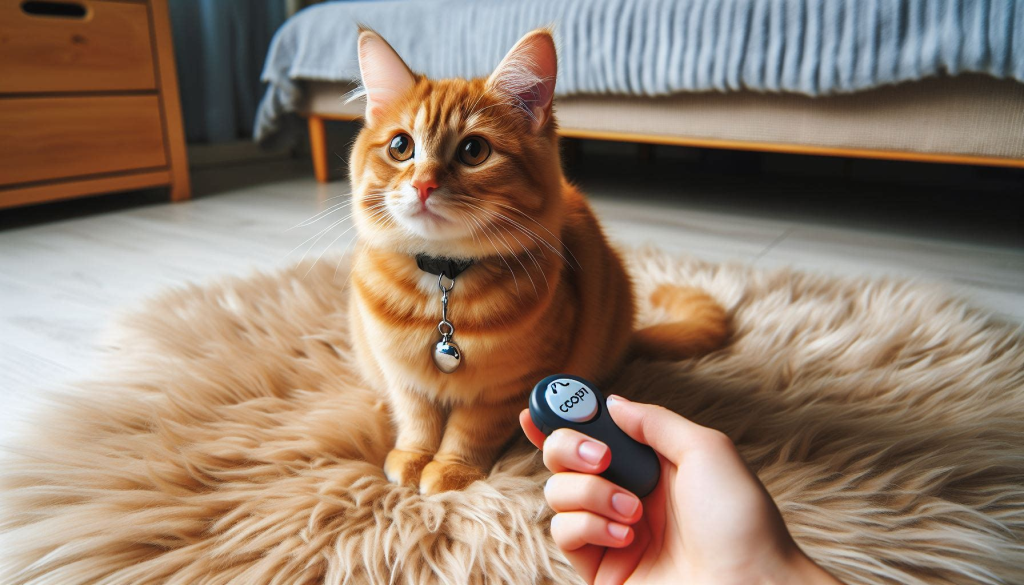
Clicker training is a positive reinforcement method. It can be used to teach Persian cats new behaviors and fix some behavior problems.
Clicker training involves:
- The Clicker: A small device that makes a clicking sound to mark the desired behavior.
- Timing: Clicking at the exact moment the desired behavior occurs.
- Rewards: Offering a treat or praise immediately after the click to reinforce the behavior.
With clicker training, you can teach your Persian cat new behaviors:
- Tricks: Such as sitting, spinning, or giving a high-five.
- Boundaries: Like staying off certain furniture or out of specific rooms.
- Social Skills: Improving interactions with people and other pets.
Modifying Unwanted Behaviors
- Discouraging Bad Habits: Redirecting from scratching furniture to using a scratching post.
- Improving Litter Box Use: Reinforcing proper litter box habits.
- Reducing Fearfulness: Building confidence through successful completion of tasks.
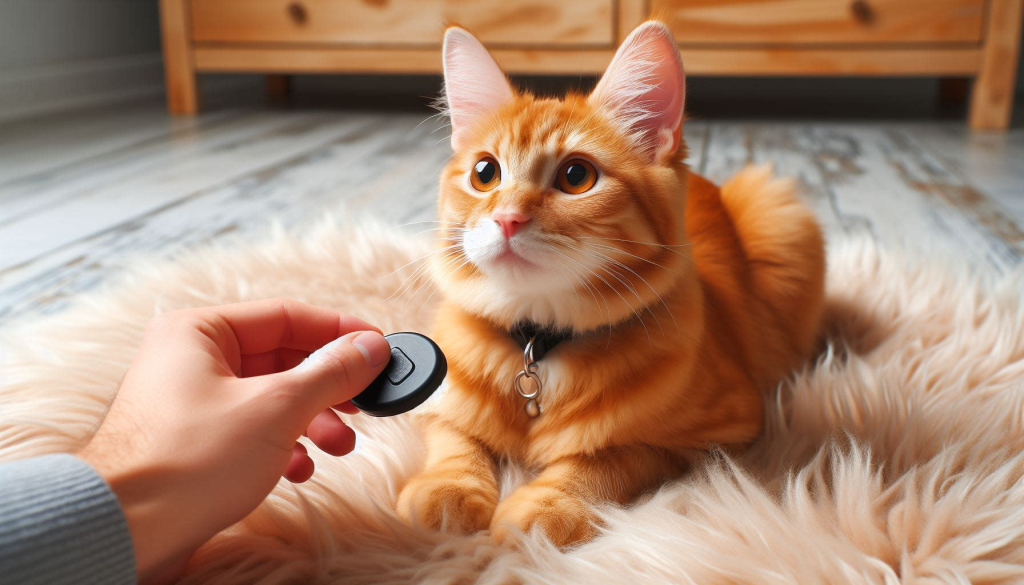
Conclusion
In this blog, we’ve explored the intricate world of Persian cat behavior, uncovering the top 11 issues that can affect these majestic felines.
We’ve covered aggression and over-grooming. We’ve also covered litter box avoidance and separation anxiety.
For each problem, we’ve looked at their causes, signs, and solutions.
The journey to resolving behavior problems in Persian cats is one of patience, understanding, and consistent care.
By recognizing the signs early and taking proactive steps, you can help your Persian cat overcome these challenges.
Remember, a happy cat feels safe, secure, and loved in its environment.
FAQs
- Are Persian cats aggressive?
Persian cats are generally known for their calm and gentle nature. However, individual personalities can vary. Aggression in Persian cats is rare but can occur due to fear, stress, or territorial issues. - Do Persian cats have an attitude?
Persian cats are often described as having a regal demeanor rather than an attitude. They can be independent and reserved but are typically affectionate companions. - Why is my cat acting weird and meowing?
Cats may act strangely and meow excessively due to various reasons such as illness, stress, boredom, or seeking attention. It’s essential to observe their behavior closely and consult a veterinarian if the behavior persists. - What if a Persian cat bites you?
If a Persian cat bites you, it’s crucial to clean the wound thoroughly to prevent infection. Assess the situation to understand why the cat bit you, such as fear, play aggression, or pain. Seek medical attention if necessary. - Why is my Persian cat biting?
Persian cats may bite due to various reasons, including fear, stress, pain, or frustration. It’s essential to identify the cause of the behavior and address it appropriately, such as providing enrichment or seeking veterinary care if needed. - What is the psychology of a Persian cat?
Persian cats are known for their calm and affectionate nature. They enjoy companionship but can also appreciate solitude. Providing a secure environment with enrichment activities is essential for their well-being. - Can Persian cats stay alone?
Persian cats can tolerate being alone for moderate periods but they thrive with human companionship. Ensure they have access to food, water, and enrichment toys to keep them mentally stimulated when alone. - What are female Persian cat behavior problems?
Female Persian cats may experience behavior problems such as territorial aggression, excessive grooming, or stress-related issues. Providing a calm and secure environment can help alleviate these problems. - What are male Persian cat behavior problems?
Male Persian cats may exhibit behavior problems such as urine marking, aggression towards other cats, or dominance issues. Neutering and providing environmental enrichment can help manage these behaviors. - Do Persian cats bite or scratch?
Persian cats may bite or scratch in certain situations, such as during play or if they feel threatened. However, they are generally gentle and prefer to avoid confrontation when possible. Proper socialization and enrichment can help minimize unwanted behaviors.


